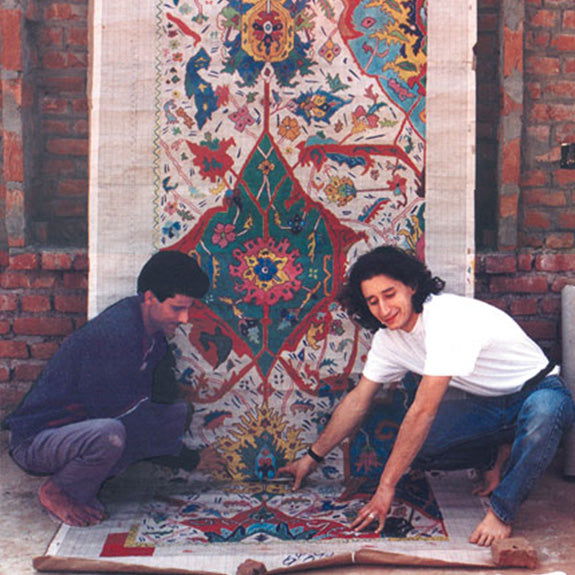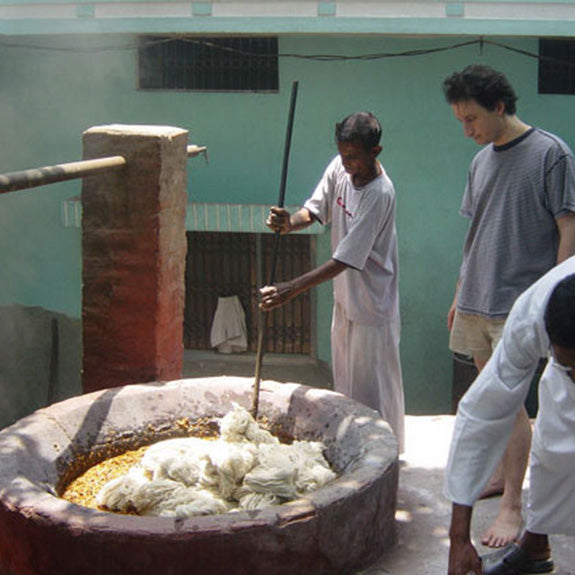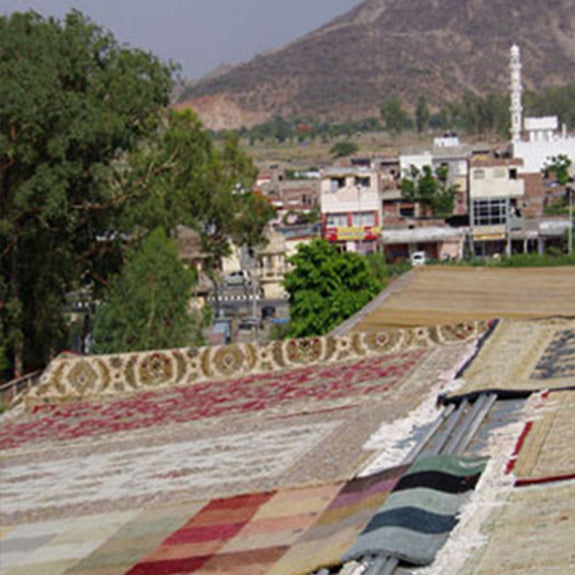How Rugs are Made

Design the Rug on Graph Paper
Here a camel pulling a cart is being drawn. Each detail must be included. A knot is woven for every square in the graph paper.

Color the Naksha, or Map
Here Jeffrey Arcari works out the colors with an artist (naksha walla) in India.

A Map to Scale is Best
Here Jeffrey Arcari and Mahkbub examine a naksha in Pakistan. Shown: Our Pakistani production

Hand-Spin the Wool
The next step is preparing the wool. Newly shorn wool must be washed and combed to straighten the fibers. We do this by hand so as not to damage the wool. Once the fibers are combed, they are spun into yarn.

Wrap the Wool into Skeins
The wool is then wrapped (wound) into loose skeins for dyeing. Shown: Our Northern Indian production

Purify the Water
If there are impurities (such as iron) in the water, this system helps remove them. Shown: Our rug production in Kathmandu, Nepal

Light A Coal Fire Hours Ahead
A fire is made under the giant dye vats. It will take hours for the water to boil. Shown: Our production in Northern India

Mordant the Wool
For certain dyes, the wool must be boiled in alum, a mordant, which makes the dye adhere to the wool. Shown: Our production in Northern India

Vegetal Dyeing is Art, Not Science
Here Jeffrey empties most of a bag of dried kaisopul flowers into the dye bath. No careful measuring here! Shown: Our production in Northern India

Add Wool to the Dye Bath
Then add the skeins of wool. Shown: Our production in Northern India

The Dye Bath Must Be Stirred
The brew must steep for hours. Shown: Our production in Northern India

Dry the Wool Anywhere!
In rug-weaving lands such as India and here in Nepal, freshly dyed wool is seen drying everywhere. Shown: Kathmandu, Nepal

Inspect Color for Consistency
Here Jeffrey works with Alabern, our production manager in Pakistan.

Make Balls So Weaving Is Easier
Here the yarn is being wrapped into balls for ease in weaving. Shown: Our production in Kathmandu, Nepal

Weave on a Tibetan Loom
The first step in weaving is stringing the loom with vertical warp threads. Weaving on a Tibetan-style loom is faster than others because the wool is wrapped around a bar and the ends of the whole row are cut at once.

Follow the Map While Weaving
The naksha is mounted on the loom for easy reference. Shown: Our production in Northern India

Big Rugs Require Big Looms
The looms must be as wide as the rug; this one is about 25 feet wide. Shown: Nepal

Soak the Rug Overnight
After the rugs are woven, they must be sheared, then thoroughly washed. The first step in washing is soaking in water for several hours or overnight. Shown: Our production in Northern India

Pour More Water on the Rug
The rug is then laid out on a clean smooth surface and more water is poured on. It was well over 100 degrees on the day this photo was taken. The men were very happy to be splashing in the water.

Get Out the Excess Dye
Large wooden paddles are used to squeeze out the excess dye. Shown: Our production in Northern India

Comb out Excess Wool
Metal combs are used to brush off the excess wool. Shown: Our production in Northern India

Dry Rugs in the Sun
Here on the roof the rugs dry quickly in the strong Indian sun. Jaipur, India

Jeffrey Shears with a Machine
This second shearing can be done by machine. Shown: Our production in Northern India

Compact the Knots if Needed
If the rug doesn't end up to be the right size or density, the knots can be condensed, but it is a tedious process. Shown: Our production in Northern India

Bokani - Separating the Lines
Long metal pokers are used to separate and neaten the straight lines of knots. Shown: Our production in Northern India

Pencil Berai - Separate Curves
Pencil-like instruments are used to separate and neaten the curved lines. Shown: Our production in Northern India

Stretch the Rugs
The rugs must be stretched on metal frames and allowed to dry to make certain they will lie flat. Shown: Our production in Northern India

Burn the Fuzz off the Backs
During weaving and the processes that follow, there is often fuzz created on the back of the rugs. This needs to be burned off so that the rug will lie flat.

Knot the Fringe
The warps need to be cut and tied to form the fringe so the knots do not unravel.

Final Shearing By Hand
This final shearing is done very carefully by hand to make sure the rug has a smooth and even finish. Northern India




